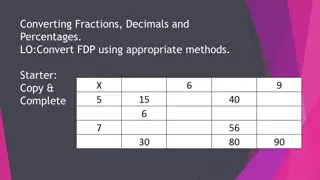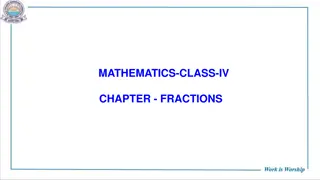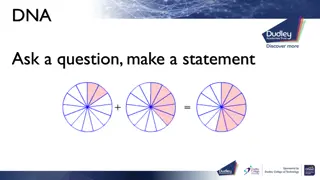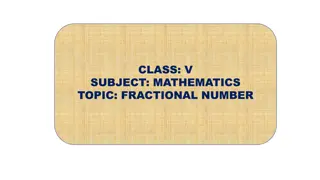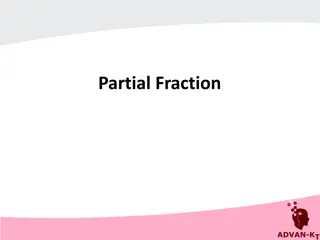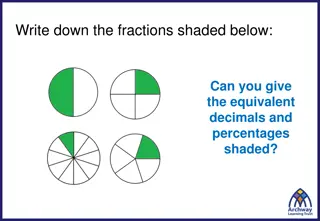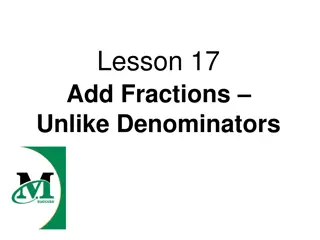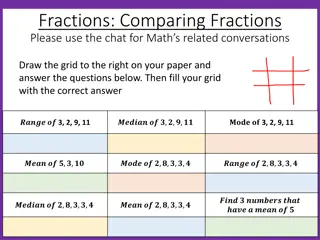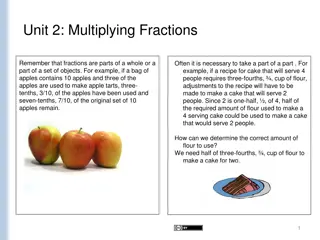
Simplified Binomial Expansion Using Partial Fractions
Learn how to simplify binomial expansions of complex expressions using partial fractions. Explore step-by-step examples and techniques to find the expansion terms efficiently up to x^3. Master the process of expressing the expansions as partial fractions for better understanding and problem-solving skills.
Download Presentation

Please find below an Image/Link to download the presentation.
The content on the website is provided AS IS for your information and personal use only. It may not be sold, licensed, or shared on other websites without obtaining consent from the author. If you encounter any issues during the download, it is possible that the publisher has removed the file from their server.
You are allowed to download the files provided on this website for personal or commercial use, subject to the condition that they are used lawfully. All files are the property of their respective owners.
The content on the website is provided AS IS for your information and personal use only. It may not be sold, licensed, or shared on other websites without obtaining consent from the author.
E N D
Presentation Transcript
Teachings for section 4C
Binomial Expansion You can use Partial fractions to simplify the expansions of more difficult expressions 4 5? Find the expansion of: up to and including the term in x3 (1 + ?)(2 ?) Express as Partial Fractions ? ? 4 5? + = (2 ?) (1 + ?) (1 + ?)(2 ?) Cross-multiply and combine ? 2 ? + ?(1 + ?) (1 + ?)(2 ?) = The numerators must be equal 4 5? = ? 2 ? + ?(1 + ?) If x = 2 6 2 = 3? = ? If x = -1 9 3 = 3? = ? Express the original fraction as Partial Fractions, using A and B 3 2 4 5? = (1 + ?) (2 ?) (1 + ?)(2 ?) 4C
Binomial Expansion You can use Partial fractions to simplify the expansions of more difficult expressions 4 5? Find the expansion of: up to and including the term in x3 (1 + ?)(2 ?) 3 2 4 5? = Both fractions can be rewritten (1 + ?) (2 ?) (1 + ?)(2 ?) = 3(1 + ?) 1 2(2 ?) 1 Expand each term separately 3(1 + ?) 1 Write out the general form: + ?? +?(? 1) +?(? 1)(? 2) ?2 ?3 1 + ?? = 1 2! 3! Sub in: x = x n = -1 Work out each term carefully + ( 1)(?) +( 1)( 2) +( 1)( 2)( 3) (?)2 (?)3 1 + ? 1 = 1 2 6 + ?2 ?3 = 1 ? Remember that this expansion is to be multiplied by 3 3 1 + ? 1 3? + 3?2 3?3 = 3 4C
Binomial Expansion You can use Partial fractions to simplify the expansions of more difficult expressions 4 5? Find the expansion of: up to and including the term in x3 3 1 + ? 1 3? + 3?2 3?3 = 3 (1 + ?)(2 ?) 3 2 4 5? = Both fractions can be rewritten (1 + ?) (2 ?) (1 + ?)(2 ?) = 3(1 + ?) 1 2(2 ?) 1 Expand each term separately 2(2 ?) 1 Take a factor 2 out of the brackets (and keep the current 2 separate ) 1 2 2 1 1 2? Both parts in the square brackets are raised to -1 1 2 2 11 1 2? Work out 2-1 1 1 2 1 1 2 2? This is actually now cancelled by the 2 outside the square bracket! 1 1 1 2? 4C
Binomial Expansion You can use Partial fractions to simplify the expansions of more difficult expressions 4 5? Find the expansion of: up to and including the term in x3 3 1 + ? 1 3? + 3?2 3?3 = 3 (1 + ?)(2 ?) 3 2 4 5? = Both fractions can be rewritten (1 + ?) (2 ?) (1 + ?)(2 ?) = 3(1 + ?) 1 2(2 ?) 1 Expand each term separately 1 1 1 2(2 ?) 1 = 2? Write out the general form: + ?? +?(? 1) + ?(? 1)(? 2) 3! ?2 ?3 1 + ?? = 1 Sub in: x =-1/2 x n = -1 Work out each term carefully 2! 2 3 1 1 ? + ( 1) 1 2? +( 1)( 2) 1 +( 1)( 2)( 3) 1 = 1 2? 2? 2 2 6 1 1 ? + 1 2? +1 4?2+1 = 1 8?3 2 4C
Binomial Expansion You can use Partial fractions to simplify the expansions of more difficult expressions 4 5? Find the expansion of: up to and including the term in x3 3 1 + ? 1 3? + 3?2 3?3 = 3 (1 + ?)(2 ?) 3 2 4 5? +?3 +?2 1 = 1 ? + ? Both fractions can be rewritten (1 + ?) (2 ?) (1 + ?)(2 ?) = 1 2 2 8 4 = 3(1 + ?) 1 2(2 ?) 1 Replace each bracket with its expansion 1 + 1 2? + 1 4?2+ 1 8?3 = (3 3? + 3?2 3?3) Subtract the second from the first (be wary of double negatives in some questions) = 2 7 2? +11 4?2 25 8?3 4C





